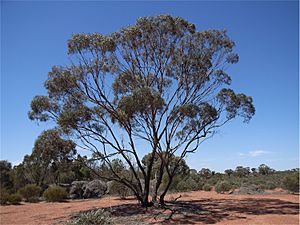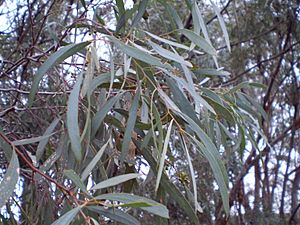Blue-leaved mallee facts for kids
Quick facts for kids Blue-leaved mallee |
|
|---|---|
 |
|
| Eucalyptus polybractea near West Wyalong | |
| Scientific classification | |
| Genus: |
Eucalyptus
|
| Species: |
polybractea
|
The Eucalyptus polybractea, often called the blue-leaved mallee or blue mallee, is a special type of mallee tree. It grows only in south-eastern Australia. This tree has rough, stringy bark on its lower trunk and smooth, greyish bark higher up. Its adult leaves are shaped like a spear, and its flower buds grow in groups of seven to eleven. When it blooms, it has white flowers, and its fruit looks like a small cup or barrel.
Contents
What it Looks Like
The Eucalyptus polybractea is a mallee tree that usually grows about 8 to 10 meters (26 to 33 feet) tall. It has a special woody swelling at its base called a lignotuber. This helps it regrow after fires. The bark on the lower part of the trunk is rough and greyish-brown. Higher up, the bark is smooth and peels off in long strips.
Young plants and new shoots have bluish or greyish-green leaves. These leaves are long and narrow, measuring 40 to 150 mm (1.6 to 5.9 inches) long and 3 to 16 mm (0.1 to 0.6 inches) wide. Adult leaves are the same bluish-green color on both sides. They are spear-shaped, 60 to 170 mm (2.4 to 6.7 inches) long and 4 to 20 mm (0.2 to 0.8 inches) wide. They narrow down to a stalk called a petiole, which is 4 to 15 mm (0.2 to 0.6 inches) long.
The flower buds grow in groups of seven, nine, or eleven. They are found where the leaves meet the stem. Each group of buds sits on a stalk called a peduncle, which is 4 to 12 mm (0.2 to 0.5 inches) long. The individual buds have tiny stalks up to 4 mm (0.2 inches) long. When the buds are ready to open, they are shaped like a club or a diamond. They are 4 to 6 mm (0.2 to 0.2 inches) long and 3 to 4 mm (0.1 to 0.2 inches) wide. Each bud has a cap called an operculum that is cone-shaped or rounded.
This tree mainly flowers from March to August, and its flowers are white. The fruit is a woody, cup-shaped or barrel-shaped capsule. It is 4 to 7 mm (0.2 to 0.3 inches) long and 3 to 5 mm (0.1 to 0.2 inches) wide. The parts that open to release seeds are almost level with the rim of the fruit.
How it Got its Name
The Eucalyptus polybractea was first officially described in 1901 by a scientist named Richard Thomas Baker. He wrote about it in a scientific paper after specimens were collected near West Wyalong.
The second part of its scientific name, polybractea, comes from two ancient words. "Poly-" is from ancient Greek and means "many." "Bractea" is from Latin and refers to the small leaf-like parts (bracts) found near flowers. So, polybractea means "many bracts." Even though many eucalypts have "many bracts," this name was chosen for this specific species.
In 2018, another scientist, Kevin James Rule, suggested there might be two different types (subspecies) of this tree. However, these names are not yet widely accepted by plant experts in Australia.
Where it Grows
The blue-leaved mallee is found in many places, but not everywhere, around West Wyalong in New South Wales. It also grows between Stawell and Bendigo in Victoria. It prefers to grow in mallee shrubland areas, especially in loamy soils (a mix of sand, silt, and clay).
How People Use It
Essential Oil
The leaves of the Eucalyptus polybractea are used to make eucalyptus oil. This oil is special because it has very high levels of a chemical called cineole, sometimes up to 91%. From the fresh leaves, about 0.7% to 5% of this oil can be extracted. The oil is mostly used for medicines and to add flavor to things.
Helping the Environment
This type of eucalypt is the most common tree planted in Australia for programs that help reduce carbon in the air. These programs are called carbon offset programs. The blue-leaved mallee is a great choice because it is native to Australia, can grow well even when there isn't much rain, and can quickly store a lot of carbon from the atmosphere.
See also
 In Spanish: Mallee de hojas azules para niños
In Spanish: Mallee de hojas azules para niños



